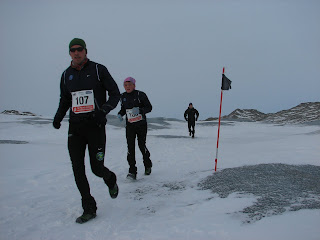The start was brutal. Three-and-a-half K uphill into the teeth of a 20 m.p.h. wind to reach the ice cap. It was 1-degree F. I was wearing a thin neck sleeve that could be pulled over the nose for warmth, but it felt as though I was breathing through an iron lung. When I pulled it down, snow whipped my face like sand.
At the ice cap (wind chill -22), we made a 3K loop. It was a hallucinatory experience. Having run that part of the course the previous day, when it was 15 degrees warmer with no wind, proved useless. Nothing looked vaguely familiar in the swirling wind. Thoughts became confused, tangled, shattered. I had no idea where I was on the course; I just kept trying to make it to the next pole in the snow. I experienced all sorts of odd sensations. I thought my running tights had drooped, exposing my hindquarters. Worse, if you'll excuse the earthy description, I was quite certain my penis had frozen and would never regain functionality.
Once we left the ice cap and headed down the hill, the event slowly took on the contours of a normal human experience-at least a normal experience for long distance runners. By the time we reached the 12K marker, the clouds and wind had disappeared. The temperature soared to a balmy 15 degrees. We were also rewarded with breathtaking views of snow-swept mountains girding mountain lakes and meandering creeks. We had driven this road the day before, but to experience it from a runner's perspective was bliss of an entirely different order.
The balance of the course was composed of slowly rolling hills on a declining arc. The road was covered with hard packed snow that made an excellent running surface. In comparison with other marathons, this was a fairly easy course, except for that bit on the ice cap, and the cumulative effect of running in cold air and wearing relatively heavy attire.
With 5K to go, the road topped a sharp hill and the ramshackle, pre-fabricated, virtually pointless hamlet of Kangerlussuaq came into view. Paris never looked so beautiful. I became fatigued in the final stages, but managed to trundle to the finish to be greeted by a throng of two. The race was won by Torben Dahl from Denmark in the boggling time of 3:02:57, five minutes off the course record (set on a day, I'll wager, when the wind chill on the cap was something other than-22).
Kudos to Albatross Tours and the very friendly people of Kangerlussuaq (who manned the aid stations for hours) for running a spectacular event. Hats off to my 99 new BFFs from around the globe for their accomplishment and excellent comraderie, a swell bunch for sure. And, a special shout out to my wife, Linda Rosner, for supporting my choice to take this wild and chilly adventure.
My time: 4:50:57 (first USA).





























